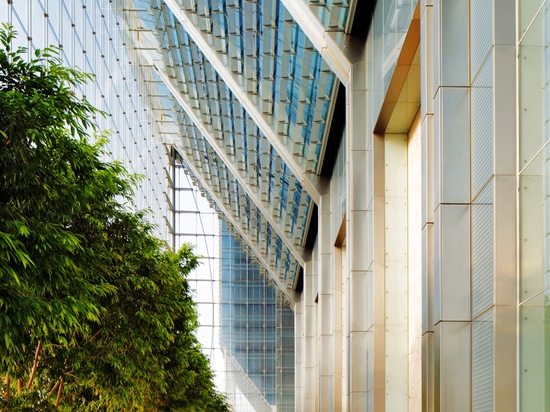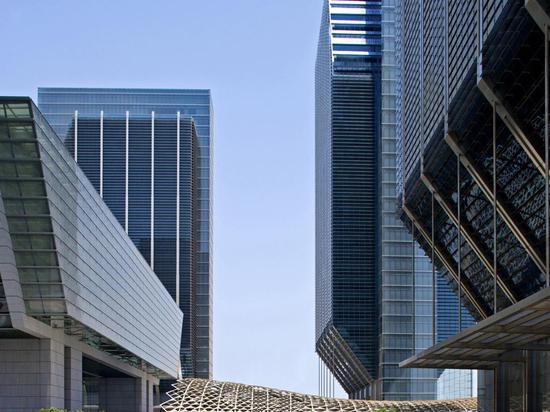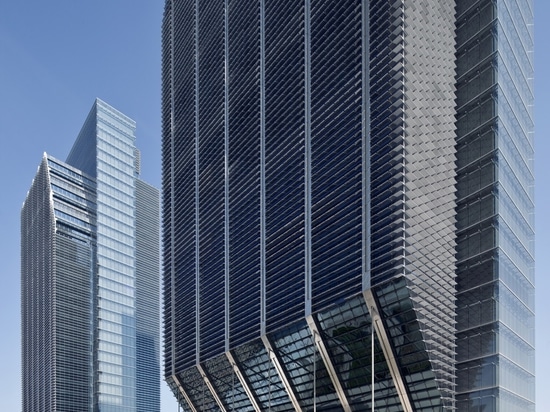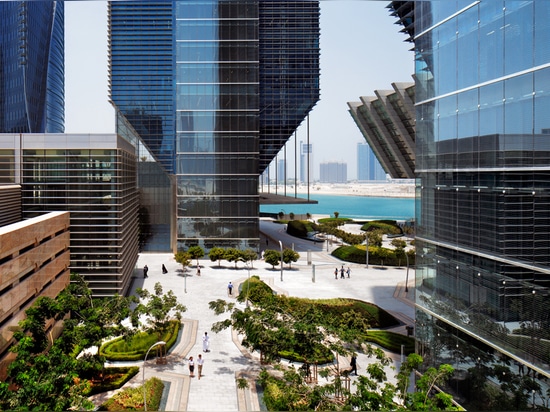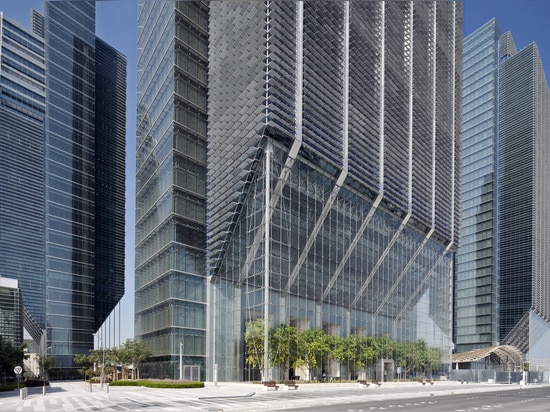
#LANDSCAPING AND URBAN PLANNING PROJECTS
Abu Dhabi Global Market Square
Al Maryah Island (formerly known as Sowwah Island) is a 114-hectare mixed-use development that serves as Abu Dhabi's International Financial Center. A key portion of the development is the five-building Abu Dhabi Global Market Square designed by Chicago's Goettsch Partners.The architects learned from some of the modern office and residential space that preceded them by integrating both active and passive sustainable design strategies suitable for the Gulf climate.
The architects at GP answered a few questions about the large project.
What were the circumstances of receiving the commission for this project?
This was a design competition. Five international architectural design firms were approached for this competition. Mubadala Real Estate and Infrastructure was the master developer. Goettsch Partners provided an iconic symbol for the securities exchange, creating a world-class international standard for speculative office space, of which the four office towers surround the securities exchange building.
Please provide an overview of the project.
As designated by Abu Dhabi’s 2030 urban framework plan, the five-building, 290,000-square-meter Sowwah Square complex defines the anchor for the new CBD. Comprising four office towers and the headquarters building for the Abu Dhabi Global Market Square, the complex strives to create a signature image for downtown while also promoting a public presence and emphasizing sustainability.
The initial building program heights were relatively modest, and their combined footprint occupied a majority of the site. In order to provide a more distinguished skyline profile and relieve the streetscape, the buildings were raised 27 meters. The resulting design frames slender pairs of 31- and 37-story towers around a stock exchange building that sits on distinctive piers. At plaza level, the buildings sparingly touch the site, and indoor and outdoor spaces seamlessly blend to create a large, landscaped, pedestrian-friendly environment. In addition, the complex integrates a two-level, 33,000-square-meter high-end shopping center and structured parking for 5,000 cars.
The project emphasized a sustainable design approach throughout. Select initiatives include ventilated, double-skin facades; active and passive solar shading; and active lighting controls that balance natural and artificial light. As a result, the complex became the first in Abu Dhabi to be pre-certified LEED-CS Gold.
What are the main ideas and inspirations influencing the design of the building?
GP provided core-supported office structures and by floating each building we created a shaded public plaza that connects all programmatic elements above the retail base. This composition created a focal point on Al Maryah Island. The design was inspired by the desire to create shade for a successful public plaza. This requirement did not compromise the design and efficiencies of the development. The solution was iconic yet inviting and supported the program.
Were there any significant challenges that arose during the project? If so, how did you respond to them?
The challenge was to create the best Class A + office space in the country. The design included floor to ceiling glass and unparalleled view corridors in a challenging climate. We developed an enclosure system that met Estidama standards for energy efficiency and tenant-user comfort. The use of active solar screening and double wall thermal pillow technology enabled us to create the desired unparalleled view corridors.
How does the building relate to contemporary architectural trends, be it sustainability, technology, etc.?
Sowwah Square is the first mixed-use project in Abu Dhabi to be pre-certified LEED-CS Gold based on sustainable initiatives. However, the complex looks beyond the LEED certification process to emphasize a sustainable design approach throughout, integrating both active and passive sustainable design strategies.
The environmentally responsive enclosure system uses a mechanically ventilated cavity and a double-skin façade system over large portions of the office buildings. These elements mitigate the 40 ºF interior/exterior temperature differential and protect building occupants from the intense sand storms and constant corrosive mist of the neighboring Gulf coast.
The double-skin cavities run uninterrupted along the entire height of the four office towers, starting from the fourth floor and extending to the penthouse mechanical floors. Within these cavities, active solar shades continuously track and adjust for the sun angle to provide optimal shading to the building’s interior. The cavity is sealed to protect the gears from airborne particulates.
Active solar shading and glass selection keep the cavity from increasing the internal radiant temperature. To minimize the amount of solar energy penetrating the outer layer of the double-skin system, an outboard fin with a very high shading coefficient (76 percent) was selected. The remaining energy was then blocked from reaching the inner façade by the active shading; however, its presence contributed to an elevated air temperature within the double-skin cavity.
Section
To alleviate the accelerated temperature and achieve the moderating air buffer, the warm cavity air needs to be flushed out using an air source cooler than the natural air temperature. The solution was to collect the exhaust air from the tower offices and, instead of allowing it to escape into the atmosphere, redirect it back down the double-skin cavities, where it is exhausted at the fourth-floor mechanical level. Sensors within the cavities modulate dampers at the top of the building, directing the air to the optimal zones of the cavity depending on the time of day and outdoor temperature. Additional dampers will allow filtered exterior air to enter directly into the cavity during economizing periods such as night and winter, when the outdoor air is cooler than the collected exhaust air.
Through these efforts, the design team expects the double-skin cavity to be an average temperature of 89 ºF (32 ºC) when the exterior temperature reaches 115 ºF (46 ºC). This condition will allow the high U-value of the insulated inner glazing to more easily block the air cavity’s radiating energy. Most importantly, calculations estimate that the double-skin system designed for Sowwah Square will generate savings of 7200 kWh of electricity per day across all four towers and provide a more comfortable thermal environment near the perimeter wall, all while protecting itself from the harsh external elements.
Site plan
How did you approach designing for Abu Dhabi/UAE and how would you describe the process of working on the project there?
We included research and awareness as a phase during initial design. We quickly understood the challenges of designing for an extreme climate (thermal heat gain, humidity, and corrosion by sand, dust and dirt during frequent wind storms). The design solutions overcame the environmental challenges and met or exceeded international Class A + office space expectations.
We also quickly understood local materials and methods, local contractor and subcontractor expertise and how they approach a construction project in the UAE. We optimized local resources and assets, understood local limitations, and delivered what was promised to our client.
Tower floor plans
How would you describe the architecture of Abu Dhabi/UAE and how does the building relate to it?
At the onset of the project (2007), we found the architecture of Abu Dhabi could be placed in two categories: iconic buildings and dated structures. Many of the iconic buildings, although symbolic, were burdened with inefficiencies that did not create long-term value for their intended purpose.
The vast majority of buildings constructed over the past several decades was out of date and not contemporary with international standards and did not meet modern tenant requirements.
We delivered an iconic office development that met market and tenant demand, even in a down market.
